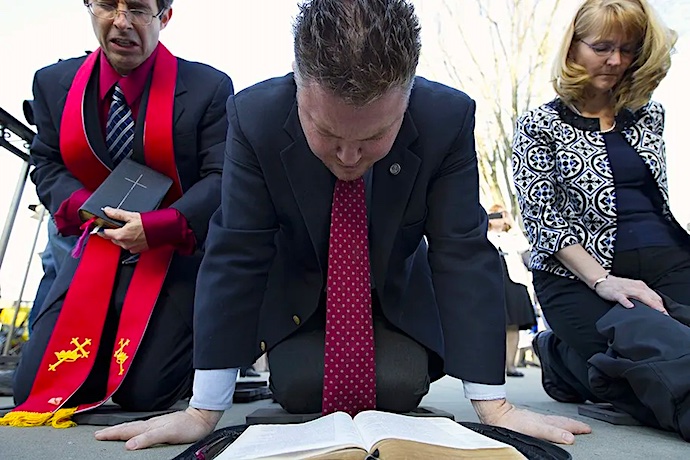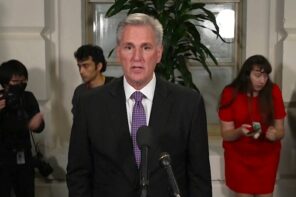The separation of church and state feels like bedrock in America. It is, after all, part of the Establishment Clause of the First Amendment—that “Congress shall make no law respecting an establishment of religion”—which has traditionally been interpreted to mean that church and state must be separated. There’s a reason this interpretation has stood, rooted deeply in American history and in the intentions of the writers. America, after all, had lots of examples of colonies where church and state were not separated, to the detriment of the members of other denominations; and that’s before the fears of a state-imposed church over them all, be it Anglican or Catholic. And yet day after day, that separation is under assault—from political leaders, from right wing pundits, from organized lobbying groups, and from the Supreme Court itself.
It’s been coming all year. Kandiss Taylor, the failed GOP gubernatorial candidate in Georgia best known for her “Jesus, Guns, Babies” campaign bus whose statements were relentlessly mocked and dismissed, declared at a campaign event in March: “We’re gonna do a political rally and we’re gonna honor Jesus. They’re not gonna tell us ‘separation of church and state.’ We are the church! We run this state!”
Now, Taylor lost, and lost badly, which made it easy to dismiss, like so many of her statements. But Lauren Boebert, who’s running for reelection to the House of Representatives, has repeated the same sentiment. Speaking to Cornerstone Christian Center at the end of June, she said, “The church is supposed to direct the government. The government is not supposed to direct the church. That is not how our Founding Fathers intended it,” along with the more quoted line, “I’m tired of this separation of church and state junk that’s not in the Constitution. It was in a stinking letter, and it means nothing like what they say it does.”
This was not a one-time thing. At a campaign rally in July, she said:
“And I believe that great Patriots all throughout this nation, and Christians, will begin to position themselves in these days, in these times, that pastors will have a boldness to speak from the pulpit of their churches, to direct and inform the church on how to influence the direction of government.”
Charlie Kirk, founder of Turning Point USA, echoed the same sentiment, that:
“There is no separation of church and state. It’s a fabrication. It’s not in the Constitution. It’s made up by secular humanists. It’s derived from a single letter that Thomas Jefferson wrote to the Danbury Baptist Convention. Of course we should have church and state mixed together. Our Founding Father believed in that.”
That “single” letter is quite clear, but is, of course, not the basis of the idea—the concept comes, once again, from the First Amendment. And then there’s the Family Research Council, which was granted church status in 2020.** They’ve also written repeatedly about the Establishment Clause, seeking originalist readings of it—with all of the typical problems of originalism—to dismantle the separation of church and state, writing:*
This is a misleading argument repeatedly trumpeted by secularists who denounce biblical morality and truth. As you probably know this often repeated mantra appears no where in our founding documents or governing documents. However, let us be clear, no one, especially bible believing Christians are calling for a state church. We do not believe any Church should rule over the State or the State over any Church, they were both created by God to fulfill separate but interrelated purposes. What is really meant by this phrase is a separation of God from government or Christians from the public square. This we unapologetically reject. We believe that since God ordained government (Rom. 13:1), He would want His people to influence it. After all, government is one of the spheres we should impact in our role as “the salt of the earth” and “the light of the world” (Matt. 5:13, 16). Active engagement is also a legitimate contemporary application for Christians in America of what the Lord Jesus called for when He commanded: “Render to Caesar the things that are Caesar’s and to God the things that are God’s” (Matt. 22:21).
It’s an interesting argument, that this is a neutral application, since the Family Research Council was connected to the “Big Lie”. Not only did Tony Perkins, Jerry Boykin and Kenneth Blackwell, the President, Executive Vice President, and Senior Fellow for Human Rights and Constitutional Governance of the FRC respectively, sign a mid-December 2020 letter championing the discredited invalid certification theory; but Blackwell and Perkins signed a second letter on December 30th urging Senate Republicans to contest votes from Georgia, Pennsylvania, Michigan, Wisconsin and Arizona.
The fever dreams of originalism, of Founders’ intentions, of the mythological idea that Revolutionary America wanted the union of church and state—be it Charlie Kirk’s ramblings or the Black-Robed Regiment idea popular in the Christian Right—are completely ahistorical.
From the earliest stages of colonization, British Americans inherited a British imperial worldview that saw themselves as a global force opposed to the excesses of the Catholic Church and its temporal nation-state allies. In fact, British opposition to Catholicism led to widespread conspiratorial views regarding the Catholic Church, its aspirations, and political or economic developments around the world. Chief among these was the view, often backed by rational evidence, that the Catholic Church wrongly viewed church and state as inseparable and that it would ceaselessly attempt to suffocate any dissent from its own Christian orthodoxy—not to mention non-Christian viewpoints.
British Americans inherited this viewpoint, and were encouraged by the home country to continue building their own worldview in opposition to Catholicism, as it solidified British nationalism among an increasingly diverse colonial population, and motivated colonists to participate in the ongoing wars between Britain and its European Catholic enemies.
Britain possessed its own state church in Anglicanism. Although far more lenient toward dissent than its Catholic counterparts, its coercion on issues such as compulsory tithe and church attendance was the main motivating factor in the colonial settlement of several dissenting religious groups such as the Puritans, Separatists, Baptists, Presbyterians, Quakers, and a variety of German pietist groups. Empowered within their own colonies, however, many of these groups went on to erect their own religious establishments that discriminated against nonconformists.
This led to recurring, and seemingly permanent, sectarian conflict between the British imperial establishment, the colonial religious establishments, and their many mutual religious dissenter groups. In short, the alliance of church and state in British America contributed significantly to the endemic tensions between Britain and its colonies, but also to the political and social instability within and between Britain’s American settlements.
These tensions between American religious groups were temporarily cast aside as political tension between Britain and her American colonies erupted into civil war with the American Revolution. In fact, a major unifying theme between Revolutionaries was their combined opposition and hostility to British attempts to reassert Anglicanism’s privileges in America as a means of consolidating its control of the increasingly lucrative and powerful colonies.
Colonists rallied around slogans such as “No Lords, Temporal or Spiritual” and “No Bishops, No Kings,” succinctly articulating their view that systems of government that fail to separate the sacred and the secular inevitably undermine not just liberty, but security and equity—qualities which, all agreed, were indispensable to commercial, political, and social stability.
Over the course of the Revolution, this perception of church and state became a central component of nascent American ideology and self-image. Both in the United States’ initial governmental system under the Articles of Confederation and it’s more capable successor under the Constitution, both political and religious leaders were emphatic, careful, public, and deliberate in their advocacy for the construction of a state that clearly and permanently prohibited the return of a marriage, even of convenience, between the church and state.
As leaders such as James Madison argued, only with such a clear disconnection between the two could a diverse set of states, communities, and interests be stabilized and unified into a coherent whole. Many who are familiar with these arguments quote Jefferson’s famous invocation to Baptists of a “wall of separation” between governance and religion, but this logic is found repeatedly in our founding documents.
From the Declaration of Independence’s admonition that “governments are instituted among men” and not God, to John Adams’ treaty with Tripoli stating that “the government of the United States is not, in any sense, founded on the Christian religion,” the founders echoed clearly and repetitively what, for them and almost all Americans, was one of the clearest lessons of European and early American experience: religious and state power are an inherently combustible mix and must be kept separate, with the one never encroaching on the other.
As Madison eloquently put it, “ecclesiastical establishments tend to great ignorance and corruption; all of which facilitates the execution of mischievous projects [that end in failure.]”
So what does this all have to do with the Supreme Court right now? The dismantling of that wall between church and state—what the New York Times has described as “the Far-Right Christian Quest for Power”—is already playing out. Kennedy v. Bremerton School District and Carson v. Makin have been seen as an attack on public schools, but they should also be seen in concert with Dobbs v. Jackson Women’s Health Organization, certainly the way it was received by GOP and Christian Right officials.
The intersection of Supreme Court justices and evangelical lobbyists doesn’t help: whether the hot mic comment from Peggy Nienaber that she prayed with Supreme Court justices in the court, while her lobbying organization was writing amicus briefs on cases like Dobbs; or Rob Schenk’s work to woo Supreme Court Justices for the same lobbying group—Faith and Liberty—earlier. And the next Supreme Court season may bring worse.
But if the claims of originalism, as a legal doctrine, are nonsense, perhaps the history of Early America might actually be helpful for the Supreme Court justices. There’s a reason why the Establishment Clause was written; a reason why Jefferson wrote to the Danbury Baptist Community; and a reason why the “Founding Fathers” sought to build a separation of church and state in our nation—they knew that it would never be enough for denominations, or religions, to get along; that some groups would try to dominate, and that tyranny required legal mechanisms to stop it.
If only the Supreme Court would figure that out, before it’s too late.
*RD’s style guide directs editors to alert readers to errors in republished texts. In this case, however, errors were too numerous and notes would have hindered more than helped. The editors would like to point out, in the interest of celebrating the unavoidable syncretism that marks all Americans—even the most ardent ‘purists’—that in consecutive sentences the staunchly evangelical Family Research Council borrows the Sanskrit word ‘mantra’ from Hinduism and fails to capitalize ‘Bible,’ one of the pillars on which evangelical culture anxiously balances.
**While this information was first revealed by ProPublica on 11 July, 2022, the application had, in fact, been approved by the IRS in July of 2020.





